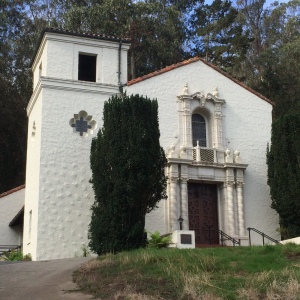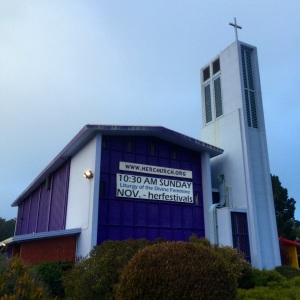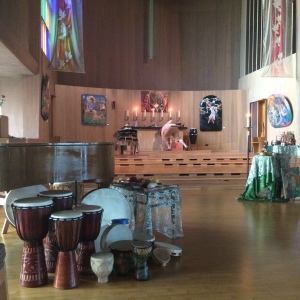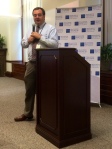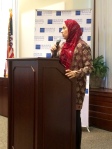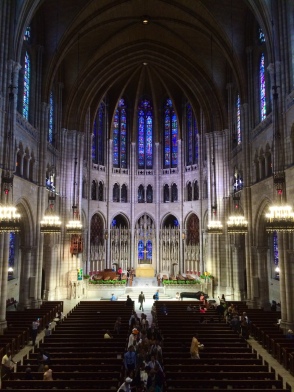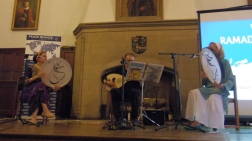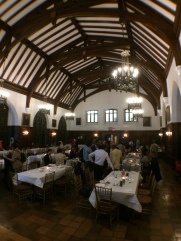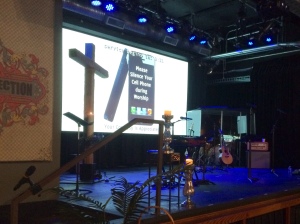Bethany Church, Baton Rouge
It was a lovely drive to Baton Rouge from New Orleans today. Along the way I stopped to visit a plantation and a couple of historic churches. But my final destination for the day was Bethany Church, which was recommended by a good friend who is familiar with the area. I looked up the church online beforehand, and I knew I had to make the trek just for this. I also knew to look for three massive crosses standing near the highway, visible from a good distance. The Bethany crosses are an icon of the area, and they are truly a sight to behold.
The church is located within an industrial complex, which seems strange until you realize how much land the church has and how many thousands congregate throughout an average weekend. I parked the car, walked toward the entrance and was immediately greeted by two very friendly staff members. One of them, Katie, walked me into the foyer and pointed out several areas of interest…the VIP table (more on that in a bit), the coffee station, the entrance to the auditorium. I was struck by the modern and bright interiors, which contrasted with the drab, warehouse look of the outside. And then we walked right by what appeared to be an ATM mounted on the wall. A churchgoer had just swiped her credit card and was in the middle of a transaction. I asked Katie what that was, and I could tell she had answered that question many times before. “A lot of people find it much more convenient to give their tithe electronically, they use their card and their tithe is withdrawn automatically,” she said. I was truly surprised, I had never seen -or known of- such a thing. “We also have the old school method,” she added, pointing to a wall pocket filled with tithing envelopes.
If you’re anything like me, you’re probably bristling at the thought of an Automated Tithing Machine. My first thought was, “Well, that is the limit! I have seen it all! This is crazy!” And then, almost immediately, I remembered how many times I’ve been upset at an independent merchant for not having a Square card reader so that I could pay with my credit card. I remembered every time I’ve wanted to give a donation or offering at a place of worship only to realize I don’t have any cash. And that’s when it hit me; this is a church for today, why would they not have an electronic option? And, why should I be surprised that they do? This is the year 2014 after all, when cash is a dirty necessary evil we have to remember to carry around for those ever-decreasing prehistoric pecuniary transactions.
My “worship experience,” as the church refers to its services, was a deep contrast with all of the historic churches and cathedrals I’ve visited lately. You won’t find sacred art in this church. You won’t see an organ or a choir loft. In fact, there isn’t even a pulpit. Instead of pews, there are comfy chairs. Instead of stained-glass windows, there are two giant projection screens flanking the stage. In place of an altar, there are bright, colorful lights and laser visualizations. As you walk in, you can’t help but notice the TV cameras hoisted upon large cranes. An outsider like myself can be easily distracted, even put off, by all of the cutting edge-technology and the exacting level of audio-visual production. But as the service begins and as I look around, the congregants don’t even seem to notice it. They are absorbed in worship, focused on what they have come here to do. To me, this resembles a sound stage for American Idol much more than it does a church. Only the music is better. A lot better.
For about thirty minutes the worship band leads the congregation in song. The band is comprised of highly skilled and talented musicians. There are two electric guitarists; one of them controls the sequenced tracks. Then there is a drummer, a pianist, a bassist and the band leader sings and plays acoustic guitar. Five supporting vocalists complete the ensemble. The music is modern and anthemic, it reminds me a lot of the upbeat drone of bands like Edward Sharpe and the Magnetic Zeroes, Coldplay and classic U2. I’m particularly moved by a beautifully arranged interpretation of The Lord’s Prayer, which is modern yet tasteful.
I say “modern yet tasteful” because although I love technology, rock music, and flawless audio-visual production, these are not the things I look for in worship. My preference is the for the high church liturgy of the Episcopal church. Give me vestments, give me bells and whistles, give me choirs in robes, give me Bach, give me gothic architecture and incense, and I’m in heaven. Those are the things I associate with the sacred. But as I’m coming to find, one man’s experience of the divine is another man’s stodgy, outdated, organized religion.
Pastor Jonathan Stockstill takes the stage as the band winds down. He leads the church in prayer and proceeds to share the results of a challenge he gave the church a couple of weeks ago. A videoclip rolls on the screens and we see church members delivering checks to financially stricken families, we see a couple of people receiving the gift of a car. I learn that in an effort to emulate the early church of Acts, Bethany Church has raised money and resources to meet the needs of their community. In just one week, the church (which counts approximately 6000 members across a number of campuses) has managed to raise nearly $80,000 to help those in need. Families on the verge of foreclosure and eviction have been provided with enough funds to avoid losing their homes. Electricity has been restored for households that have lost power due to their inability to pay the bills. And of the six cars that were donated, two have already been given to people in need of transportation. This is amazing stuff, and nothing about it seems inauthentic. Pastor Stockstill talks about “unlocking the hand of generosity,” and he asserts that “this is how the early church did it.”
The second half of the service consists of Pastor Stockstill’s sermon. He is a gifted and charismatic preacher. He speaks about the power of prayer, emphasizing the need for Christians to pray both in private and corporately. He confesses that even for him, prayer is still a struggle. It is a discipline and a requirement for all Christians, “not just the hyper spiritual ones,” he says. He preaches from the book of Acts and on a couple of occasions he asks us, if we have our Bibles, to turn to a certain chapter and verse. Only this is isn’t really necessary as scripture passages appear on the large TV monitor by his side, from which he reads them aloud. A life without prayer is aimless and empty, as he says; it is merely religion. “Religion is doing a God-thing without God,” he proclaims, adding that we want to have a relationship, not a religion.
The service ends with a call to prayer and a call to accept Jesus Christ, for those who haven’t already done so. A few hands are raised and Pastor Stockstill says a special prayer for them. He asks for those who have made a decision to accept Jesus to please head for the VIP table in the foyer so that church volunteers may meet with them, answer any questions and give them a gift. And then the band takes the stage once again and church is dismissed with a refrain of an earlier song. I did not raise my hand during prayer, but I head for the VIP table all the same because that’s where Katie has invited me to meet after service for a chat.
People are gathered around the coffee station; there are cookies, too. Parents are retrieving their children from child care and kids’ activities. When I see Katie again I tell her how much I enjoyed the service. She asks me to fill out a visitors card and gives me a VIP folder with information about the church. Enclosed is a CD with a welcome message from Pastor Stockstill as well as three tracks by the worship band. I also get a reusable cup and straw emblazoned with the church’s logo. It’s all really quite nice. I remark about the prevalence of technology throughout the church and how user-friendly my worship experience has been. She tells me they make every effort to have visitors and members feel as welcome as possible. She tells me about the history of the church, which has just celebrated its 51st anniversary. It’s been about 14 years since they moved into the current space and a lot has changed since then.
The church was founded by Roy Stockstill and later taken over by his son, Larry Stockstill. Three years ago, Larry’s son, Jonathan assumed the pastorship and things really started changing. Katie tells me Bethany was already a vibrant church, with great worship music and preaching, but it looked nothing like what it does today. With Pastor Jonathan in place, the church started moving quickly into a more technology-driven experience. In came the screens, the concert lighting, the electronic tithing station and the smartphone app. The church moved firmly into the online age. But the improvements did not stop with technology. In fact, technology simply enabled the congregation to be more actively engaged in the life of the church. Katie joined a wave of volunteers three years ago and today she is on staff as Volunteer Coordinator. Programs were developed, small groups instituted, ministry opportunities created, and with all of this the church has experienced significant growth. Today, the church holds three weekend services on this campus as well as various other services throught their other campuses. They have also begun a Spanish service which is already averaging one hundred in attendance. This church is alive and engaged. It is a spiritually-rich and community-driven body that reflects in its membership a diversity across generations, race, and socio-economic levels.
I’ve already taken quite a bit of Katie’s time by this point and she has work to do, so I say my thank-yous and I go sit on a comfy couch in the lobby. As I reach for my phone, I wonder if they have a wireless internet connection. Of course they do. This makes me smile. I may be an old soul when it comes to church, but I’ve changed my mind about modern Christianity. I no longer see all of these technological advances as trappings or gimmicks. Why should Christianity today conform to my Luddite preferences? I was brought up in the Nazarene church, a conservative evangelical tradition. And as I logged on to Bethany’s guest wifi I remembered the time I learned how so many of the hymns in the Nazarene hymnal were original drinking songs (or so I was told). I thought about how many times the church has reinvented itself through the ages, changing with the times. I think about all the technological, architectural and engineering advances made in the construction of cathedrals of old. And it makes perfect sense that today’s church should be at the forefront, that it should make use of modern technology and music in worship. It seems such a simple yet significant realization, the church remains relevant in great part because it adapts to our modern proclivities.
As I leave, a t-shirt worn by a volunteer catches my eye. It reads, “Church doesn’t start until the service is over.” It takes me back to what I heard earlier, about how this church raised so much money and so many resources for the neediest in their community. And, it also makes me realize a very important truth. The church is not the flying buttresses, the jumbotrons, the pipe organ, the electric guitars. The church is not the alms boxes, the automated tithing machines, the prayer books, the smartphone apps. The church is the people.







